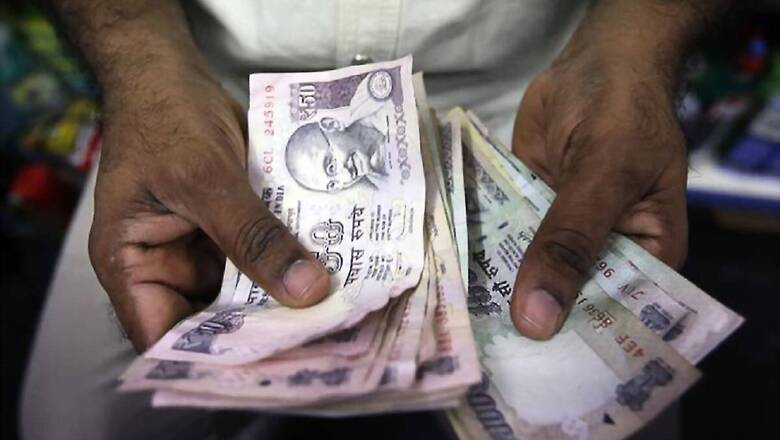
views
For India to become a $5-trillion economy, lending needs to be done at a massive scale to ensure both businesses and individuals can grow. As NITI Aayog CEO Amitabh Kant pointed out, India’s private credit-to-GDP ratio (about 51 per cent) is lowest among its global peers and we need to increase private debt. Countries such as China, South Korea and even Vietnam have had tremendous growth on the back of high leverage. Similarly, the tax to GDP ratio in India is also among the lowest and somewhere the two are co-related.
There is a large financing gap within MSMEs (Micro, Small and Medium Enterprises) as well as individuals; where the credit penetration in India is below 15 per cent. Less than 20 per cent of MSMEs have access to formal credit amid an estimated MSME debt demand of Rs 70 trillion or Rs 70 lakh crore.
MSMEs, with 63 million units, constitute about 90 per cent of all enterprises in India, employ over 120 million people and contribute significantly to the GDP. But 85 per cent of MSMEs are unregistered. More than 70 per cent of them are micro-enterprises, in active need of microfinance.
MSMEs have limited access to funding, especially in smaller towns and villages, where they are primarily based, and have to resort to informal sources for debt such as family, friends, local moneylenders and chit funds. They end up paying higher rates on loans borrowed with high collateral.
India is data-rich but not economically rich. Data may help solve the puzzle of self-employed, informal segment and sachet lending. Open banking with Open Credit Enablement Network (OCEN) and Account Aggregator framework along with the proposed Public Credit Registry (PCR), which would be a repository of all credit-related information, would together help plug the information gaps and give a fillip to MSME lending.
What is Account Aggregator Framework (AA)?
The Reserve Bank of India (RBI) has established a legal framework for a class of regulated data fiduciary entities, called Account Aggregators (AA), enabling customer data to be shared within the regulated financial system with the customer’s knowledge and consent, through the use of APIs or Application Programming Interface.
It thereby separates the role of custodian (Bank) and permission/consent collector (Account Aggregator), similar to the separation of bank as the custodian and the payment service provider (PSP) in the UPI payment infrastructure. This is very similar to the revised payment services (PSD2) directive in the European Union wherein banks would be required to share customer information (account details, credit card history etc.) with other financial institutions.
Consumers can selectively share and even revoke data once shared. Currently, using AA handles, borrowers can consent to share officially verified asset-based data, such as bank accounts, deposits, mutual funds, insurance policies, pension funds with lenders that will be incorporated in the onboarding, underwriting and monitoring process. Other types of data, such as home loan repayment record, credit card statements, Income Tax returns, GST returns etc., are likely to be added over time.
Let us look at an illustration. An individual, for instance, wants to apply for a personal loan with a bank. If they have signed up and given consent to an AA, it will source data from multiple Financial Information Providers or FIPs and submit the data to the bank. The individual here does not have to physically provide hard copies of documents from various FIPs or download information to be submitted to the lenders.
Data would come directly from the source, tamper-proof, at a low cost and in real-time. This would bring down the cost and burden of verifying the data. The biggest challenge for an issuer remains income assessment. AA would help share businesses’ operational data in real-time to lenders. Bank account data, GST business flows or payment history could serve as collateral to get cash flow-based loans. AA would facilitate early-warning systems, as lenders can better monitor cash flows and anticipate default before it happens.
The big question is whether AA will neutralize the advantage that banks enjoy from their Liability Franchise. AA would democratise lending—so far, banks enjoyed the privilege of data.
Meanwhile, AA could help banks in getting continuous data regarding new-to-bank or NTB customers, thereby making them comfortable with lending to NTBs. Open access to data could also lower switching costs for customers and generally foster competition and financial inclusion.
AA cannot read or resell consumer data. Therefore, unlike in UPI, where Big Tech and third party applications drove user adoption by aggressive marketing to attain scale, inability to monetize data (given AA are data blind) may limit investment in customer onboarding.
Onboarding and scale up will therefore be slow and gradual, as and when customers need a loan, unless mandated by a regulator as in the case of e-KYC.
What is OCEN & How Does It Work?
Another interesting development in this regard is the Open Credit Enablement Network (OCEN), which is expected to democratise credit by using AA as enablers. OCEN is a free digital public good. The OCEN protocol provides a standardized set of APIs so that applications that already interface with individuals and MSMEs can effectively ‘plug-in’ lending capabilities into their current product and service offerings.
OCEN is designed to enable many types of loan service providers or LSPs offering diverse ‘species’ of credit products. OCEN seeks to reimagine the lending ecosystem so that any service provider that interfaces with consumers and MSMEs can become a Fintech-enabled credit marketplace, or more specifically, a Loan Service Provider.
OCEN will be launched through an app called Sahay. This is just one of the first apps (Sahay GST and Sahay GeM) on which OCEN would be launched. Sahay would enable MSMEs to access loans in as few as 5-10 minutes. Conceptualised and promoted by iSpirit, Sahay is to OCEN what BHIM app was for UPI. Just like payments, Sahay would democratize lending across multiple platforms.
Let us discuss an illustration of a seller on the Government e-marketplace (GeM) obtaining invoice financing through the Sahay GeM LSP. For example, the Airport Authority of India (AAI) places an order for 10 laptops. This demand is listed on the GeM portal. Multiple suppliers bid for the order. Then AAI selects a particular supplier. Once the order is accepted by the buyer, the seller can select a GeM Sahay option on the GeM portal.
The seller then gives explicit consent on GeM portal to avail credit against accepted order. Seller is directed to install Sahay GeM mobile app and link GeM account through GSTN. Once the account is linked, all his GeM orders and approved invoices with different buyers would be available on the platform to be shared with the lenders for financing offers.
So there would be two opportunities, one at the order stage and one for the invoices already sold by the supplier. For both these opportunities, the seller would be able to ask for credit. They can avail credit for up to 70 per cent of the order value from multiple lenders for 130 days (delivery 90 days and payment 45 days). In the second case where they have already delivered the goods, they can get invoicing up to 95 per cent of the invoice value for 45 days. Somewhere here the AA would be assimilated with data.
Different lenders can give the seller options with different interest rates. The seller can select a borrower. Then sign up a digital facility agreement, verify the loan agreement through an OTP. Then, the seller has to set up his repayment and update a new bank account into GeM. With a single click, they can get the loan disbursed.
Anyone can become an LSP by adopting OCEN APIs. Lending would not be limited to just banks, a Non-Banking Financial Company (NBFC) or lending FinTech but also e-commerce companies, such as Amazon, Flipkart (based on seller’s invoices), cab hailing aggregators like Ola (based on driver’s rides) or food delivery platforms like Swiggy (based on restaurant orders) etc.
Almost 30 customer-facing entities across segments of tax and filing, payment gateways, agri-tech companies, kirana-tech, health and wellness among others are looking to become loan service providers and adopt this protocol.
The merchants would be able to sign up and get instant loans from the lending partner bank and NBFC by providing GST ID number and their bank details. This will enable enhanced access to funding for the excluded segments such as small businesses and street vendors.
Sahay’s launch has been put on hold last year. When the lending cycle picks up again in the market, Sahay would be launched to bring cash flow-based lending products in the market.
Technology is enabling MSMEs to get faster and cheaper access to capital, based on their business fundamentals. This can be a turning point for formalization and digitization of Indian economy.
Read all the Latest News, Breaking News and Coronavirus News here. Follow us on Facebook, Twitter and Telegram.




















Comments
0 comment